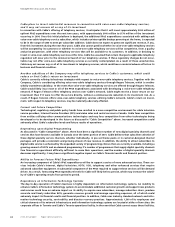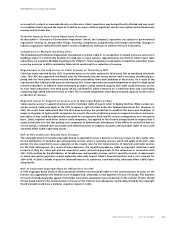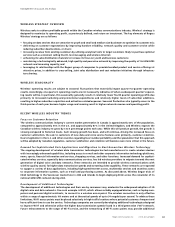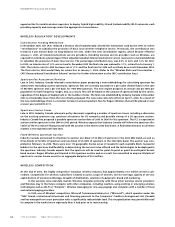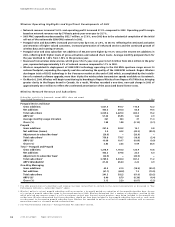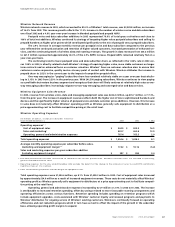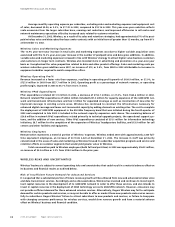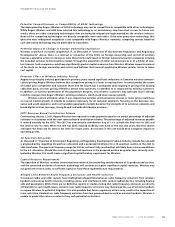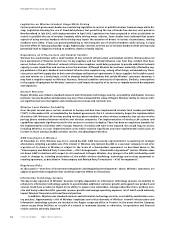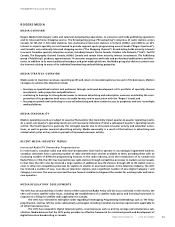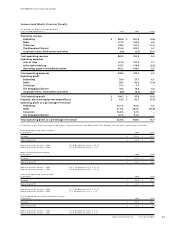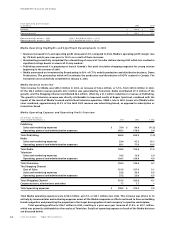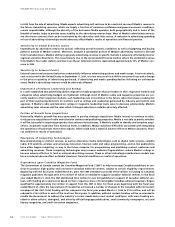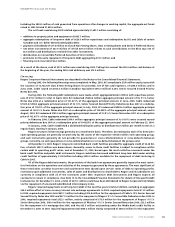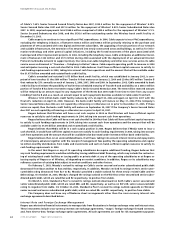Rogers 2003 Annual Report Download - page 52
Download and view the complete annual report
Please find page 52 of the 2003 Rogers annual report below. You can navigate through the pages in the report by either clicking on the pages listed below, or by using the keyword search tool below to find specific information within the annual report.
2003 Annual Report Rogers Communications Inc.
50
Legislation on Wireless Handset Usage While Driving
Certain provincial government bodies are considering legislation to restrict or prohibit wireless handset usage while dri-
ving. Legislation banning the use of hand-held phones, but permitting the use of hands-free devices, was passed in
Newfoundland in late 2002, with implementation in April 2003. Legislation has been proposed in other jurisdictions to
restrict or prohibit the use of wireless handsets while driving motor vehicles. Some studies have indicated that certain
aspects of using wireless handsets while driving may impair the attention of drivers in various circumstances, making
accidents more likely. If laws are passed prohibiting or restricting the use of wireless handsets while driving, it could
have the effect of reducing subscriber usage. Additionally, concerns over the use of wireless handsets while driving could
potentially lead to litigation relating to accidents, deaths or bodily injuries.
Dependence on Infrastructure and Handset Vendors
Wireless has relationships with a small number of key network infrastructure and handset vendors. Wireless does not
have operational or financial control over its key suppliers and has limited influence over how they conduct their busi-
nesses. Failure of one of Wireless’ network infrastructure suppliers could delay programs to provide additional network
capacity or new capabilities and services across the business. Although Wireless has not been materially affected by sup-
ply problems in the past, handsets and network infrastructure suppliers may, among other things, extend delivery times,
raise prices and limit supply due to their own shortages and business requirements. If these suppliers fail to deliver prod-
ucts and services on a timely basis, or fail to develop and deliver handsets that satisfy Wireless’ customers’ demands, it
may have a negative impact on Wireless’ business, financial condition and results of operations. Similarly, interruptions
in the supply of equipment for Wireless’ networks could impact the quality of its service or impede network development
and expansion.
Disaster Recovery
Rogers Wireless uses industry standard network and information technology security, survivability and disaster recovery
practices. Security breaches and disasters may occur that are beyond the scope of Rogers Wireless’ ability to recover with-
out significant service interruption and commensurate revenue and customer loss.
Wireless Local Number Portability
Over the past several years, certain countries in Europe and Asia have implemented wireless local number portability
(“LNP”). In November 2003, as mandated by the Federal government, the U.S. wireless industry began the implementation
of wireless LNP. Wireless LNP involves porting wireless phone numbers to other wireless companies, but can also involve
porting phone numbers between wireline and wireless companies. The implementation of wireless LNP systems and
capabilities represents significant costs for the carriers in a country to deploy. There has been no regulatory mandate for
the implementation of wireless LNP in Canada. However, if wireless LNP were to be required, this would require carriers,
including Wireless, to incur implementation costs which could be significant and once implemented could cause an
increase in churn among Canadian wireless carriers, including Rogers Wireless.
AWE Investment in Wireless
At December 31, 2003, Wireless was 34.2% owned by AWE. AWE has recently reported that it is exploring its strategic
alternatives, including a possible sale of its interest in Wireless. Any decision by AWE or a successor company to sell all or
a portion of its shares in Wireless is subject to the terms of a shareholders agreement, as described above in the
“Intercompany and Related Party Transactions – AT&T Arrangements – Shareholders Agreement” section. Wireless does
not know AWE’s intentions with respect to its investment in Rogers Wireless. Any change in the AWE relationship could
result in changes to, including termination of, the mobile wireless marketing, technology and services agreement or
roaming agreement, as described in “Intercompany and Related Party Transactions – AT&T Arrangements”.
Regulatory Risks
As discussed in “Overview of Government Regulation and Regulating Developments” above, Wireless’ operations are
subject to government regulation that could have adverse effects on its business.
Information Technology Systems
The day-to-day operation of Wireless’ business is highly dependent on information technology systems. An inability to
enhance its information technology systems to accommodate additional customer growth and support new products and
services could have an adverse impact on its ability to acquire new subscribers, manage subscriber churn, produce accu-
rate and timely subscriber bills, generate revenue growth and manage operating expenses, all of which could adversely
impact Wireless’ financial results and financial position.
In addition, Wireless uses standard network and information technology security, survivability and disaster recov-
ery practices. Approximately 1,400 of Wireless’ employees and critical elements of Wireless’ network infrastructure and
information technology systems are located at the Rogers corporate office in Toronto. In the event that the Company
cannot access these facilities, as a result of a natural or manmade disaster or otherwise, its operations and financial
results could be adversely impacted.
Management’s Discussion and Analysis


